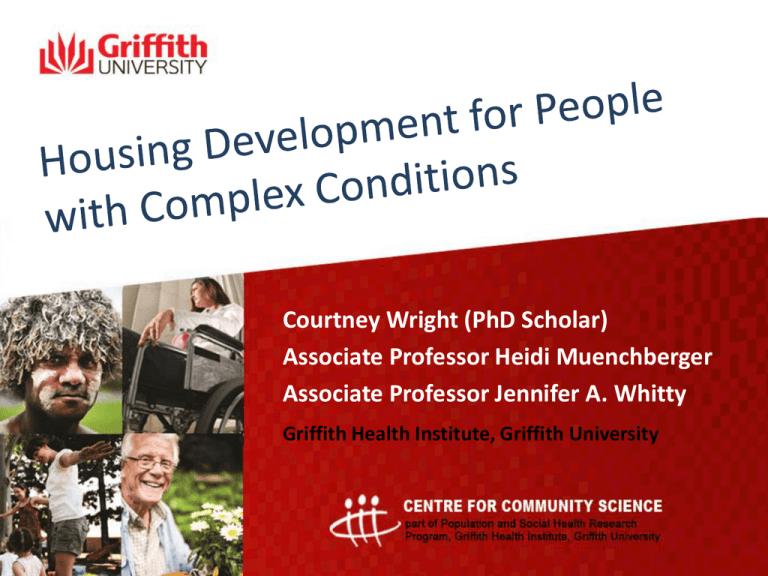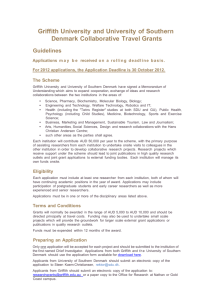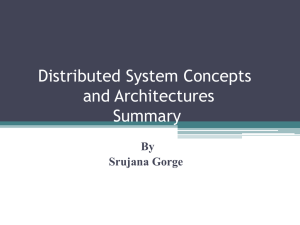Housing Development for People with Complex
advertisement

Courtney Wright (PhD Scholar) Associate Professor Heidi Muenchberger Associate Professor Jennifer A. Whitty Griffith Health Institute, Griffith University Presentation Outline • Background – Research Aims • An Environmental Approach to Housing Design and Development • Understanding Consumer Housing Preferences • Methodology • Research into Action – Key Findings – Implications and actions for policy makers – Implications and actions for practice • Acknowledgements Research Aims 1. Identify an environmental approach to housing design and development for improved biological, psychological, and social (biopsychosocial) health and wellness. 2. Systematically identify housing characteristics (and preferred combinations thereof) valued by consumers with complex health conditions to guide future residential design and (re)development decisions. A new direction for disability housing: One that is based on consumer preferences and conducive to a person’s biopsychosocial health An Environmental Approach to Housing Design & Development • Housing Context: Three key housing domains 1. Intrinsic Design 2. Location 3. Neighbourhood • Individual viewed as a “whole” We already know consumers have preferences regarding these housing domains. For more information, please contact Ms. Courtney Wright at Griffith University (ph: 07 3382 1112; email: Courtney.wright@griffith.edu.au) The Need for a Consumer Preference Approach • Properly engaging with consumers redefines disability • A preference approach borrowed from health economics Discrete Choice Experiment (DCE) Survey: Example Question Methodology Study 1 A Literature Synthesis: Systematic Literature Review Study 2 Qualitative Data Collection: Semi-structured interviews Participant studies: Mixed-method design Study 3 Quantitative Data Collection: Discrete Choice Experiment (DCE) survey Discrete Choice Experiment (DCE) • Systematic Literature Review • Qualitative Interviews (n=24) • DCE Preference Survey (n=400+) Study 2: Semi-Structured Interviews (Preliminary Findings: n=15/24) Participants: • 15 consumers purposively sampled (QLD) – Neurological health condition: n=8 (0 Brain Injury; 3 Spinal Cord Injury; 2 Spinal Muscular Atrophy; 1 Multiple Sclerosis; 2 Cerebral Palsy) – Relative: n=5 (4 mothers; 1 paternal grandmother) – Non-family carer: n=1 (support worker) – Combined group: n=1 (person with a neurological health condition & carer for her husband also with a neurological health condition). • Age range: 33-79; majority female (n=10; 66.7%) Research into Action Key Findings – Preliminary Research Revealed: 1. Intrinsic design, location & neighbourhood considerations imperative 2. Physical, psychological and social environments interact to affect individuals’ biopsychosocial health Findings supported by literature review & the housing features mentioned by participants in Study 2 (preliminary likes, dislikes & ‘must-haves’ emerged – but need to be tested in DCE survey) Research into Action Implications and actions for policy makers • Adoption of an environmental approach to a minimum standard of housing development for people with disability • Policies to ensure social housing provision (at a minimum) informed by consumer preference research – Preferred housing characteristics and combinations thereof Research into Action Implications and actions for practice For key stakeholders: • Market-relevant, viable housing solutions For consumers: • Choice of stable housing alternatives indicative of consumer aspirations and priorities • Increased self-determination • Improved quality of life After all, is a choice between two inappropriate or unsuitable housing alternatives still a choice? Acknowledgements This work is funded by The Department of Science, Information Technology, Innovation and the Arts (DSITIA) on behalf of the Queensland Government under Grant 42323 (Smart State Fellowship) and sponsored by Youngcare. Sincere gratitude is owed to Associate Professor Heidi Muenchberger and Associate Professor Jennifer Whitty for their ongoing excellent supervision of this research program. Preferred citation: Wright, C., Muenchberger, H., & Whitty, J. A. (2014). Housing development for people with complex conditions. National Disability Insurance Scheme Symposium, 10 June 2014. Griffith University, Brisbane, Queensland, Australia.











